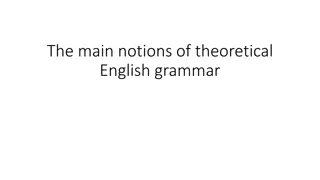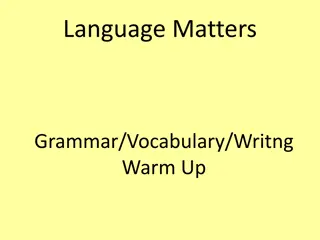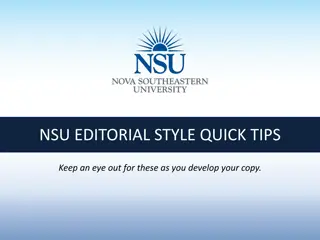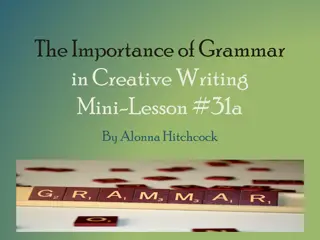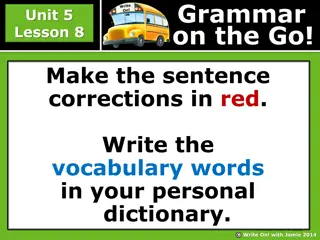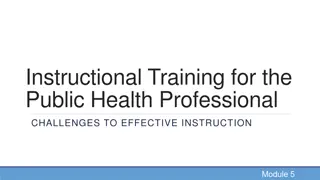
Essential Tools for Journalists: AP Style and Grammar Unveiled
Delve into the world of AP style and grammar, essential for journalists. Explore the history, importance, and impact of adhering to precise writing guidelines. Discover why the AP Stylebook is irreplaceable, even in the age of digital tools. Uncover examples showcasing the difference between conventional writing and AP style, ensuring clarity, consistency, and accuracy in your work.
Download Presentation

Please find below an Image/Link to download the presentation.
The content on the website is provided AS IS for your information and personal use only. It may not be sold, licensed, or shared on other websites without obtaining consent from the author. If you encounter any issues during the download, it is possible that the publisher has removed the file from their server.
You are allowed to download the files provided on this website for personal or commercial use, subject to the condition that they are used lawfully. All files are the property of their respective owners.
The content on the website is provided AS IS for your information and personal use only. It may not be sold, licensed, or shared on other websites without obtaining consent from the author.
E N D
Presentation Transcript
AP style and grammar Essential tools for journalists
but some things haven t. The essentials: Writing and editing Accuracy and fairness Grammar and style
Grammar has always been around (even if we don t always get it) but what about style?
In 1953, journalists finally got some style.
Meet the Associated Press Stylebook.
What is AP style? The rulebook for newswriting. As AP says, its part dictionary, part textbook, part encyclopedia.
Cant I just use google? No. And here s why: The AP Stylebook was created to give an accurate, consistent presentation of the printed word.
How many opportunities for inconsistent presentation can you find below? At an E.U. summit yesterday, President George W. Bush spoke to twenty-seven leaders about United States policies in the Mideast.
Did you count six? At an E.U. summit yesterday, President George W. Bush spoke to the twenty-seven leaders about United States policies in the Mideast.
Same paragraph, adjusted for AP style: At a European Union summit Sunday, President Bush spoke to the 27 member states about U.S. policies in the Middle East.
Even if spelling variations are correct, they re confusing: Al-Qaida Al-Qaeda al-Qaida Al qaida al-Qaeda Al Qaida
Avoid confusion by following a consistent style. Al-Qaida Al-Qaeda al-Qaida (AP style) Al qaida al-Qaeda Al Qaida
Why students AP Style: need Position: Internship Company: Chicago Tribune Requirements: you ll also need to have a solid knowledge of AP style
Why students AP Style: need Position: Sports Reporter Company: The Arizona Daily Sun Job Status: Full-time Requirements: the ideal candidate has a firm grasp of AP style
Why students AP Style: need Position: Web News Editor Location: Detroit, Michigan Job Status: Full-time Requirements: must have knowledge of editing and AP Stylebook standards. A writing/editing test will be given
Students need to know: 1. What to look up. 2. How to find it. Let s take a tour
What to look up: The basics Proper nouns Numbers Time references Directions and regions Abbreviations/acronyms
Proper nouns The stylebook tells you when and why to capitalize nouns. The Democratic Party sponsored a rally outside Gov. O Neill s office. But The party sponsored a rally outside the governor s office.
Proper nouns Some basic AP rules: Capitalize nouns that constitute the unique identification for a specific person, place or thing. Examples: John, Mary, America, Boston, England
Proper nouns Some basic AP rules: Capitalize common nouns such as party, river, street and west when they are an integral part of the full name for a person, place or thing. Examples: Republican Party, Mississippi River, Fleet Street, West Virginia
Proper nouns BUT: Lowercase those common nouns when they stand alone in subsequent references: the party, the river, the street, go west
Proper nouns Other rules (and exceptions) are found throughout the stylebook, under entries such as: Brand names Historical periods Governmental bodies Nationalities and races Organizations Trademarks
What to look up: The Basics Proper nouns Numbers Time references Directions and regions Abbreviations/acronyms
Numbers The stylebook tells you when and why to use numerals or spell them out. He invited two of his friends. But He has a 2-year-old daughter.
Numbers Some basic AP rules: Spell out whole numbers below 10, and use figures for 10 and above. Example: I ll bring six cans of soda and 12 paper plates to the picnic.
Numbers BUT: With ages, always use figures for people and animals (but not inanimate objects). Examples: The 5-year-old boy. The 10-year-old girl. The boy, 5, has a sister, 10. My parents are in their 70s.
Numbers Other rules (and exceptions) about numbers are found under entries such as: addresses dates dimensions percentages speeds times statistics
What to look up: The Basics Proper nouns Numbers Time references Directions and regions Abbreviations/acronyms
Time references The stylebook tells you how to present the time of day, the day of week, a calendar date, year or decade. The New Year s countdown begins at 11:59 p.m. or Crime rates spiked in the 1980s.
Time references Some basic AP rules: Use figures except for noon and midnight. Only use a colon to separate hours from minutes: 11 a.m. (not 11:00 a.m.) But 11:03 a.m.
Time references Some basic AP rules: Avoid such redundancies as: 7 a.m. Thursday morning (AP style is 7 a.m. Thursday)
Time references Some basic AP rules: Do not abbreviate days of the week. Use the day of the week (Monday, Tuesday, etc.) rather than using today, tomorrow or yesterday.
Time references Some basic AP rules: For a month with a specific date, abbreviate all but March, April, May, June, July. Example: Dec. 25, 1999. For a month with a year, do not separate with commas: January 1972 For a month, day and year, set off the year with commas: Jan.
Time references Some basic AP rules: When referring to a decade, show a plural by adding the letter s: the 1920s. (Note: no apostrophe before the s) But Use an apostrophe to indicate numerals that are left out: the roaring 20s.
What to look up: The Basics Proper nouns Numbers Time references Directions and regions Abbreviations/acronyms
Directions and regions The stylebook tells you when to capitalize/lowercase or when to abbreviate/spell out the names of compass directions, regional designations and states.
Directions and regions Some basic AP rules: In general, lowercase north, south, northeast, etc., for compass direction. Example: The storm headed east. But Capitalize when they designate regions.
Directions and regions Some basic AP rules: Lowercase compass points when they describe a section of a state or city (eastern Idaho, northern Arizona) But Capitalize when part of a proper name (West Virginia, North Korea)
Directions and regions Some basic AP rules: State names should be spelled out when they stand alone. (Montana) But Abbreviate them in conjunction with a city, county or town. (Missoula, Mont.) (Note: Do not use two-letter Postal Service abbreviations
Directions and regions Exception to the rule: Eight states are not abbreviated in text: Alaska, Hawaii, Idaho, Iowa, Maine, Ohio, Texas and Utah. A tip for remembering the eight: Two are the states not part of contiguous U.S. The rest are states with five
State Abbreviations Directions and regions Ala. Ariz. Ark. Calif. Colo. Conn. N.Y. Del. Fla. Ga. Ill. Ind. Kan. Ky. La. Md. Mass. Vt. Mich. Va. Minn. Wash. Miss. Mo. Mont. Wyo. Neb. Nev. N.H. N.J. N.M. N.C. N.D. Okla. Ore. Pa. R.I. S.C. S.D. Tenn. You should always spell out Alaska, Hawaii, Idaho, Iowa, Maine, Ohio, Texas, and Utah. Abbreviate all other states. W.Va. Wis.
What to look up: The Basics Proper nouns Numbers Time references Directions and regions Abbreviations/acronyms
Abbreviations & acronyms The stylebook tells you when it s appropriate to abbreviate or use acronyms and how to do so correctly. NASA (not N.A.S.A or written out) No. 1 (not Number One or number 1) John F. Kennedy Jr. (not
Abbreviations & acronyms Some basic AP rules: BEFORE a name: Abbreviate formal titles. Dr. Joyce Brothers Gov. Schwarzenegger Rep. Newt Gingrich the Rev. Al Sharpton Sen. Harry Reid
Abbreviations & acronyms Some basic AP rules: AFTER a name: Abbreviate junior or senior. Abbreviate company, corporation, incorporated and limited. Examples: (Note: no comma before Jr.) PepsiCo Inc. Exxon Mobil Corp. Hank Williams Jr.
Abbreviations & acronyms Some basic AP rules: Don t follow an organization s full name with an acronym in parentheses. (NOTE: If the acronym wouldn t be commonly known on second reference, don t use it.) National Rifle Association (NRA) National Rifle Association (use NRA on second reference in story).
Abbreviations & acronyms Other rules are found throughout the stylebook, under entries such as: Company names Courtesy titles Military titles Religious titles Academic titles / Academic degrees Organizations and institutions Judge / Court names
The secret to mastering style 1.Don t panic. Nobody is expected to memorize the whole stylebook. (After all, it s almost 500 pages long!)
The secret to mastering style 2. Master the basics. The most common rules and topical entries (like the ones in this presentation) will become familiar very quickly.

